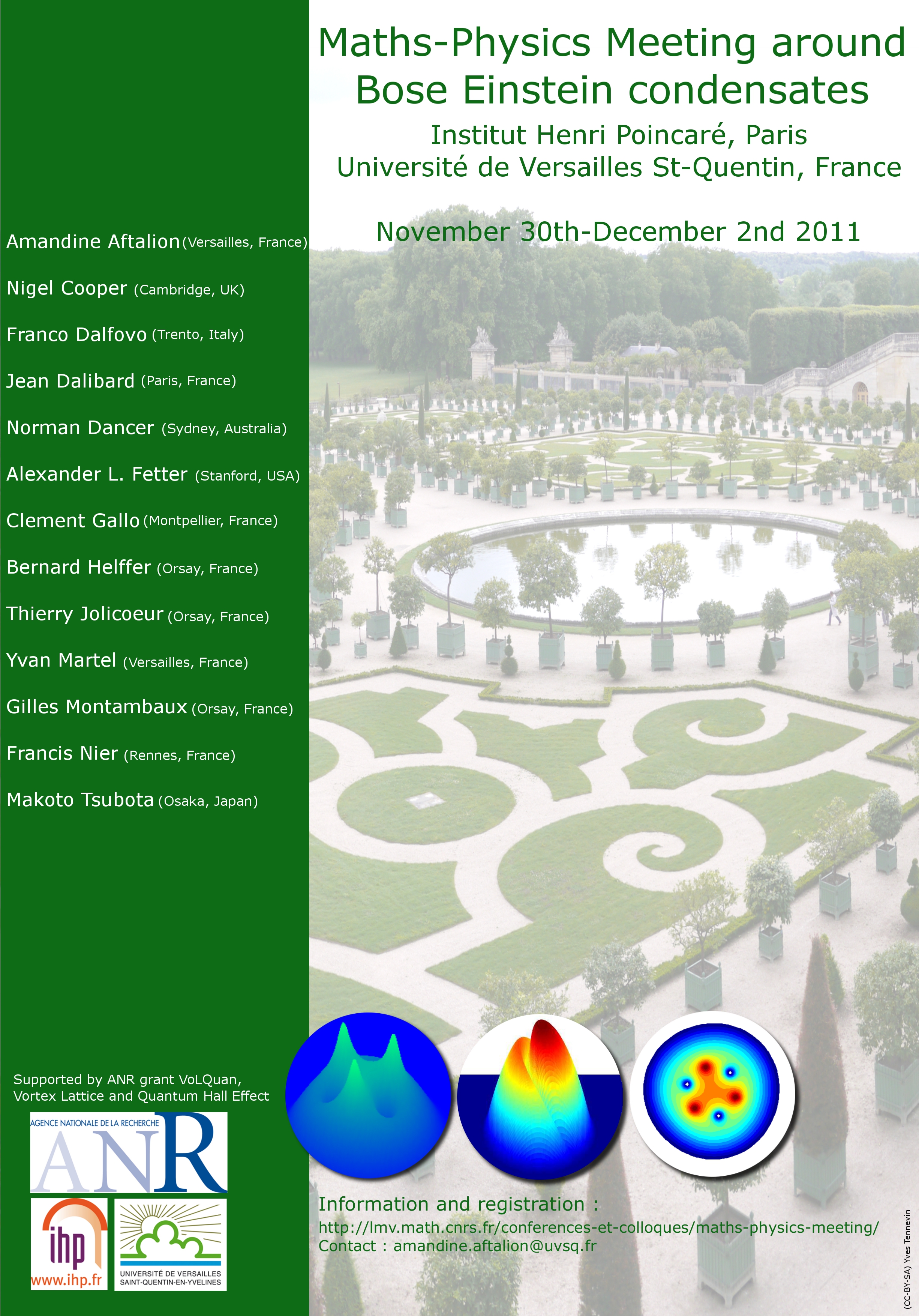


  |
 |
| Members of the project Mathematicians
Physicists
Postdoc on the project Peter Mason |
ANR-Blan-0238VoLQuan
|
 |
Aims of the project The aim of this project is to tackle mathematical issues that are relevant for problems at the core of international interest in physics, and for which several Nobel prizes have been awarded : the Quantum Hall effect in Bose Einstein condensates. For that purpose, our group is made up of two teams, one of mathematicians and one of physicists. International context in physics : Superfluidity and superconductivity are two spectacular manifestations of quantum mechanics at the macroscopic scale. Among their striking charac- teristics is the existence of vortices with quantized circulation. The physics of such vortices is of tremendous importance in the field of quantum fluids and extends beyond condensed matter physics. Indeed, rearrangements of a vortex lattice in the interior of neutron stars have been proposed as an explanation of the so-called "glitches" in the rotation frequency of pulsars. The cosmic strings are topological line defects of cosmological extent akin to the vortices of liquid Helium and their role in galaxy formation is the subject of present research in cosmology. Ultracold gaseous Bose-Einstein condensates allow tests in the laboratory to study various aspects of macroscopic quantum physics. In particular, the quest for vortices has been immediate. The possibility of tuning many parameters of the system through atomic physics techniques turns these gaseous systems into extremely attractive objects. Motivation of the project : In 2000, the ENS team of Jean Dalibard at Laboratoire Kastler- Brossel succeeded in observing vortices in a single component Bose Einstein condensate, fol- lowed by teams at the MIT and Oxford. This has triggered of many mathematical works on vortices and the Abrikosov vortex lattice.1 All these experimental situations are described by a mean-field approach, where the system is characterized by a macroscopic wave function sol- ving the Gross-Pitaevskii or nonlinear Schrodinger equation. The mathematical tools involve PDE's, energy estimates, homogeneisation, analysis of the spectrum of some operator, and more recently semi-classical analysis and the introduction of Bargmann spaces. Our interest in this project is still in the vortex lattice, but in a situation where the mean field model is no longer valid because the states are highly correlated, similarly to the fractional quantum Hall states of electrons in two-dimensional structures. Thus, one has to consider the quantum N body hamiltonian. Current Interest and objectives : To nucleate vortices, one has to add a certain amount of angular momentum to the gas. This can be done by rotation. Current physical interest is now for a rapid rotation regime : the rotation frequency becomes close to the transverse trapping frequency. The centrifugal and trapping forces then nearly compensate each other and the spatial extent of the condensate becomes very large. This is a most interesting regime since it is equivalent to the situation leading to the quantum Hall effect in two-dimensional electron gases. Depending on the ratio between the number of vortices and the number of particles, the ground state of the system will be well approximated by a macroscopic wave function or it will be a strongly correlated state. The former case is the one that we have started to study but that still leads to very interesting open questions, in particular on the study of the Abrikosov lattice, as well as the behaviour of the lattice (melting) as a function of temperature. The case of strongly correlated states is even more fascinating as it is directly connected to the physics of fractional Quantum Hall phenomena. This regime has not yet been reached experimentally. It is the core of our project and requires the analysis of the quantum N body hamiltonian for bosons. The issues that we want to understand are new and open mathematically. Indeed, all the mathematical works on the thermodynamical limit lead to situations where the asymptotic problem is de-correlated and thus the methods cannot be used as such. Our problems display links with very di±cult questions in random matrix theory, in particular for estimating the norm of the so-called Laughlin wave functions. We will need to use as much as possible tools coming from statistical physics for Coulomb gases and problems on electrons. The team of physicists is expert for this type of problems. In previous collaborations with physicists, the mathematical team have proved its ability and dynamism for interdisciplinary aspects. It involves well known specialists of the tools that will be needed. Our team has the talent to match the challenges raised by this ambitious and innovative research program. We hope to gain knowledge of a fundamental nature which may then be related to current experiments and applied to more conventional condensed matter systems. |